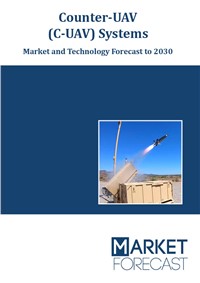Counter-UAV (C-UAV) systems gained demand when present radar detectors and missile systems faced challenges to detect Low, Slow and Small (LSS) UAVs. Designs of small UAVs are such that detecting them through conventional radar systems is difficult and classifying the difference between UAVs and birds is a challenge. Therefore, such UAVs are taking advantage of the system’s flaws and are used for recce and surveillance and are used as loitering munitions. Almost all nations are using small UAVs against enemies, drug traffickers and urban warfare.
Hence, today developing counter-UAV systems to tackle LSS UAVs have become a growing business. This business is young and yet developing. What is working fast in this business is developing customised solutions using COTS sensors and soft-kill technologies. This is good for urban detection, tracking and mitigation. Such C-UAV systems are in demand for airports, places of importance and securing air traffic near government offices and military bases.
For battlegrounds; solutions such as land-to-air defence using handguns, vehicle-mounted multi-layer C-UAV systems and air-to-air countermeasures are used. Many innovative ground-based fixed and mobile, vehicle-mounted and ship-mounted solutions can be seen developed in recent years.
The trend of launching the Centre of Excellence is seen prominently in C-UAV solution development. provide facilities for the simulation, testing, verification and validation of C-UAV programmes, and lab and field tests for sensors, directed-energy weapons and system assemblies.
Public-private partnerships are encouraged through competitions, and trial projects to avail expertise from companies knowing emerging software technologies, SwaP-enabled designs and using open architecture. Hence business scope is vast and commercial-enterprise solution providers are gaining benefits from this new trend.
For low-cost mitigation, there are ongoing experiments with directed-energy weapon systems. Laser beams and microwave-based weapon systems are in the front row. Such systems are banned to be used on humans under Protocol IV of the 1980 Convention. However, these seem allowed against Unmanned systems. These are more convenient and economical than using missiles and ammunition. Therefore, these days there is a surge in the developments, field trials and fielding of directed energy systems.
Software-defined radios and Command and Control software seem to play a crucial role in RF-based and cellular-based UAV detection and classification. Modern UAVs can fly and hop through a vast range of RF frequencies, making detection and classification a tough job. The use of SDRs and C2 software along with machine learning algorithms are becoming helpful in the classification and tracking of such UAVs.
The opportunities that we see in this business are for open-source-based, modular, small-sized solutions that can be portable. The cost of the system will be crucial and integrating these systems with remote-controlled weapon systems will be a need.
Covered in this report
- Overview: Snapshot of the C-UAV Market during 2022 - 2030, including highlights of the demand drivers, trends, and challenges. It also provides a snapshot of the procurement plans concerning regions as well as components, types, and platforms. It sheds light on the emergence of new platforms like 3D and 4D AESA radars, SDRs, and COTS software to seamlessly operate multi-vendor and multi-layer sensors and mitigation systems and emerging technologies such as machine learning algorithms.
- Market Dynamics: Insights into the technological developments in the detection sensors and low-cost UAV mitigation solutions such as directed-energy weapon systems and handheld guns and integration of emerging technologies changing preferences of soldier lethality, connectivity and performance metrics around the world. It also analyzes changing industry procurement structure and the challenges faced by the industry participants.
- Segment Analysis: Insights into the C-UAV Market from a segmental perspective and a detailed analysis of factors influencing the market for each segment.
- Regional Review: Insights into present C-UAV developments status and future developments for top countries within a region.
- Regional Analysis: Insights into the C-UAV Market from a regional perspective and a detailed analysis of factors influencing the market for each region.
- Trend Analysis - Key Defense Market: Analysis of the key markets in each region, providing an analysis of the C-UAV systems expected to be initiated in each region.
- Competitive landscape analysis: Analysis of the competitive landscape of the global public and private industries participating in the development, testing, and fielding of various programmes under the soldier modernization drive. It provides an overview of key companies, together with insights such as product range, strategic partnerships and SWOT analysis.
Segmentation
We have segmented the market by Region, Platform, Product, and End-Use.Region
- North America
- Europe
- Asia
- Middle East
- South America
Platform
- Handheld
- Fixed Mobile/Vehicle mounted
- Airborne
- Naval
Product
- Detection Technologies
- Mitigation Technologies
- Comprehensive System
End-User
- Army
- Air Force Navy
- Homeland Commercial
Reasons to buy
- Determine prospective procurement areas based on a detailed procurement plan analysis of the C-UAV market over the next eight years.
- Gain an in-depth understanding of the underlying factors driving demand for different C-UAV systems in the leading countries and other potential markets across the world and identify the opportunities offered by each of them
- Strengthen your understanding of the market in terms of demand drivers, industry trends, and the latest technological developments, among others.
- Identify the major channels that are driving the global C-UAV Markets, providing a clear picture of future opportunities that can be tapped, resulting in revenue expansion.
- Make correct business decisions based on a thorough analysis of the total competitive landscape of the sector with detailed profiles of the C-UAV solution providers around the world.




